Inflammation of the middle ear is a disease that often provokes an infection. Pathology is characterized by damage to the structure of the tympanic cavity. In the absence of timely treatment, inflammatory processes develop rapidly and provoke serious complications. At home, therapy is carried out after consulting an otolaryngologist.
Record content:
-
1 Views
- 1.1 Acute inflammation
- 1.2 Chronic inflammation
-
2 Stages and degrees
- 2.1 Early stage
- 2.2 Second stage
- 2.3 Repair
- 3 Symptoms and Signs
- 4 Causes
- 5 Diagnostics
-
6 Treatment methods
- 6.1 Drug therapy
- 6.2 Folk remedies
- 6.3 Operation
- 7 Potential consequences and complications
- 8 Video about otitis media
Views
Taking into account the course of the inflammatory process with lesions of the middle ear, there is a certain classification of the disease in medicine. Each type of otitis media is accompanied by characteristic symptoms and requires a properly selected therapy to prevent possible complications.
Acute inflammation
The disease is characterized by rapid development. At first, the person complains of minor disturbances, discomfort and tingling in the ear area. As the inflammation progresses, a strong pain syndrome appears, which periodically intensifies and subsides.
Acute otitis media is more often diagnosed in young children. They cannot talk about their problems, so they become restless, whiny, refuse to eat and do not respond to the voice of adults.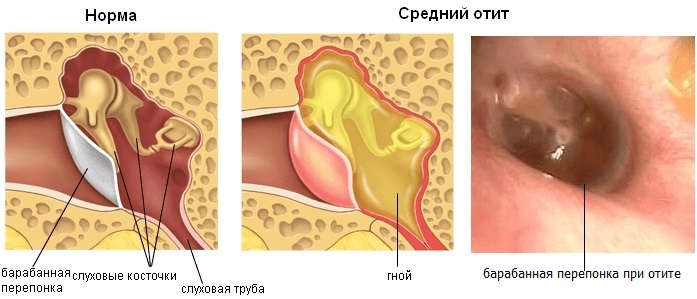
Acute inflammation develops over 2-3 weeks. When purulent discharge appears, painful sensations decrease. Treatment should be selected by an otolaryngologist. Otherwise, inflammation will lead to damage to the structures of the central nervous system.
Chronic inflammation
The disease is characterized by a sluggish course with periodic exacerbations against the background of the influence of negative factors. Chronic otitis media often results from improper or untimely treatment of acute otitis media. There is swelling and thickening of the mucous membrane of the tympanic membrane. The patient complains of headaches, purulent discharge, tinnitus.
Stages and degrees
Middle ear inflammation develops gradually. At each stage of the progression of the disease, characteristic clinical symptoms and pathological changes appear.
Early stage
The inflammatory process in the middle ear is accompanied by a slight pain syndrome and symptoms of intoxication. A person complains of general weakness in the body, as with colds.
Painful sensations arise as a result of irritation of the endings of the cranial nerves. The attack is pulsating, radiating to the jaw and temple from the affected side of the head. The pain increases when the patient bends forward.
The soft tissues in the middle ear swell, as a result of which the mobility of the auditory ossicles deteriorates and hearing is impaired. The tympanic membrane thickens, purulent accumulations are formed.
Second stage
At this stage, inflammation of the middle ear is characterized by perforation of the tympanic membrane. Purulent contents flow out of it. Pathological changes bring some relief to a person, pain and symptoms of intoxication are reduced. During the examination, the otolaryngologist will find damage to the tympanic membrane, through which discharge appears.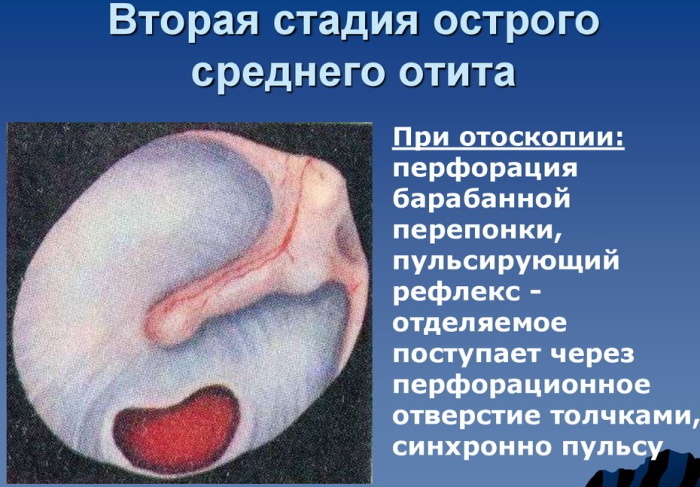
At this stage, purulent accumulations are dangerous because they may not come out. They penetrate the cranium, resulting in serious complications that are life-threatening.
Repair
The last stage of the inflammatory process in the middle ear. At this stage, scarring of the damaged tympanic membrane occurs. All signs of the disease disappear, the functioning of the hearing aid is restored. Lesions of small diameter heal without traces.
Large holes are tightened with connective tissue. In this situation, scarring can occur in the middle ear cavity. The mobility and functioning of the auditory ossicles is impaired, which provokes hearing problems.
Symptoms and Signs
The clinical picture with inflammation of the middle ear will allow the otolaryngologist to determine the stage of the disease and the extent of the spread of the pathological focus. The specialist takes into account all the patient's complaints in order to schedule an informative examination.
Middle ear inflammation (home treatment is carried out after a comprehensive diagnosis, strictly according to the doctor's prescription) accompanied by the following clinical signs:
- severe pain syndrome that occurs at an early stage of the development of the disease;
- hearing impairment of varying degrees;
- clogs the ear;
- purulent-mucous discharge comes out of the ear canal;
- a runny nose appears, which is accompanied by discomfort and pain in the throat;
- there is a feeling of strong pressure;
- there is a feeling of a foreign body in the ear canal;
- regional lymph nodes increase;
- autophony develops (the perception of one's voice increases);
- severe dizziness appears;
- there is tinnitus;
- symptoms of intoxication appear (weakness, nausea, vomiting, chills, fever);
- the skin behind the ear swells and turns red;
- sleep disturbances;
- appetite worsens.

Pain syndrome with a lesion of the middle ear passes to the teeth, the back of the head, the temple from the affected side. Hearing is impaired up to the onset of partial or complete deafness. The ear clogs, but when swallowing, the discomfort disappears.
Causes
In most cases, inflammation of the middle ear is provoked by pathogenic microorganisms. They enter the cavity of the auditory organ through the Eustachian tube. More often, the disease is diagnosed in children, since a small organism is just developing. Its imperfect immune system is weak against provoking factors.
Given the type of otitis media, the causative agents of the inflammatory process are pathogenic microorganisms:
| Name | Causes |
| Bacterial otitis media | Inflammation is provoked by streptococci, staphylococci, Pseudomonas aeruginosa, moraxella, pneumococci, haemophilus influenzae. |
| Viral | Inflammation often develops after viral diseases (respiratory, childhood infections). |
| Fungal otitis media | The causative agents of the inflammatory process are fungal microorganisms. |
It is necessary to highlight the provoking factors that contribute to a decrease in immune defense and activation of pathogenic microflora:
- dirty fluid that has entered the ear canal;
- hypothermia of the body;
- unhealthy diet (the diet is overflowing with foods that reduce immunity);
- high air humidity in the room;
- active removal of earwax (it protects the mucous membrane of the ear canal from drying out, water and microorganisms);
- hereditary predisposition;
- the ingress of a foreign body into the auditory canal;
- surgery on the pharynx or paranasal sinuses;
- genetic abnormalities in the development of the auditory organs;
- improper cleaning of the nose;
- the use of a hearing aid.
Middle ear inflammation (home treatment is carried out after a complete examination based on the established diagnosis) in some situations, it occurs along with concomitant diseases:
- adenoiditis;
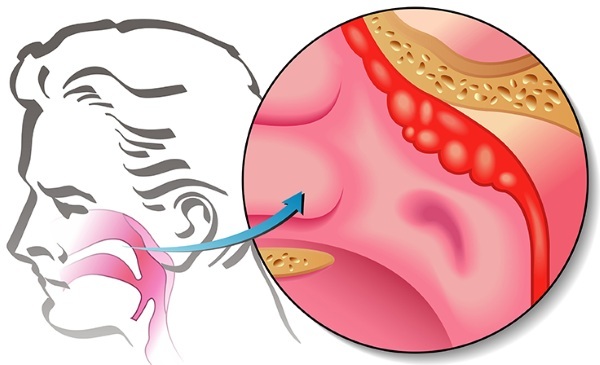
- allergic reaction;
- damage to the throat and nose;
- respiratory infections;
- damage to the nose;
- meningitis;
- tumor neoplasms;
- osteochondrosis of the cervical spine.
The symptoms of the inflammatory process cannot be ignored, since the thin and small eardrum is easily damaged by any negative factors. The end result of this condition is trauma to the auditory ossicles and impaired transmission of sound signals.
Diagnostics
A comprehensive examination for inflammation of the middle ear is necessary for the patient in order to establish the cause of the pathological condition. The otolaryngologist, taking into account the patient's complaints, prescribes the most informative diagnostic measures for him:
| Name | Description |
| General urine analysis | The inflammatory process is accompanied by high protein levels. |
| Microbiological research | Discharge from the ear canal is tested. Experts determine the type of causative agent of the inflammatory process and its sensitivity to antibacterial drugs. |
| Hemogram | Blood parameters change with the development of the inflammatory process in the human body (the level of leukocytes and the erythrocyte sedimentation rate increase). |
| Otoscopy | A specialist visually examines the eardrum using medical instruments. Revealed its protrusion, swelling and hyperemia.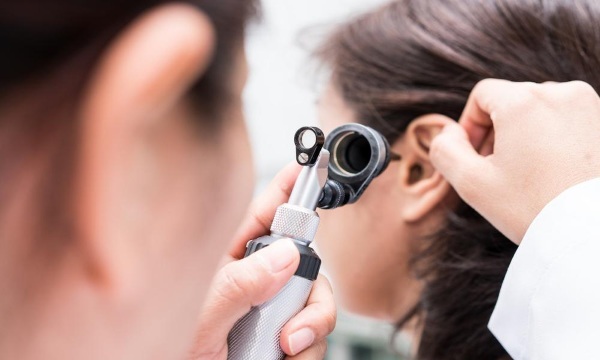
|
| X-ray | The most informative diagnostic methods that are prescribed to patients in difficult situations or when complications arise. The results will show the extent of the inflammatory process and the area of damage to the hearing organs. |
| Computed tomogram (CT) | |
| Audiometry | The degree of hearing impairment is determined. |
| Tympanometry | The ability of the tympanic membrane and ossicles to conduct a wave of auditory pressure is assessed. |
It is important to differentiate the disease, since many inflammatory pathologies of the hearing organs are accompanied by similar clinical symptoms (histiocytosis, mumps, swelling, eczema). The results of the examination are also necessary to draw up the most effective therapy regimen.
Treatment methods
Treatment of otitis media at home is carried out after consultation with an otolaryngologist. The specialist will select the most effective and safe means, guided by the results of diagnostics and the individual characteristics of the human body.
It is important to adhere strictly to the recommendations to reduce the likelihood of side effects and complications.
Drug therapy
To treat the inflammatory process, the otolaryngologist prescribes medications to patients that will help eliminate the symptoms of the disease.
| Drug group | Name | Application |
| Antibacterial drugs | Ofloxacin, Neomycin | Medicines are prescribed in the form of drops. They act directly on inflammatory pathogens. The medicine is dripped 10 drops into the ear canal 2 times a day. The course of treatment lasts 10 days. |
| Decongestants | Nazivin, Rinonorm | The drugs reduce swelling in the nasopharynx and restore the patency of the auditory canal. Adult patients are prescribed 1-2 drops 2-3 times a day. The course of treatment lasts no more than 7 days. |
| Anti-inflammatory drugs | Otipax, Sofradex | The drugs act on pathogenic flora and reduce inflammation. The medicine is instilled into the ear canal 2-3 times a day, 4 drops for 10 days. |
| Antipyretic drugs | Ibuprofen, Paracetamol | The drugs lower body temperature and reduce pain and inflammation. The dosage for the patient is selected individually, on average 400-600 mg 3-4 times a day. |
| Antihistamines | Suprastin, Zodak | Medicines eliminate the edema of the eardrum and restore the patency of the auditory tube. The drug is taken orally during meals, washed down with a sufficient amount of liquid. Adults are prescribed 0.025 g 2-3 times a day. |
| Immunomodulators | Imunoriks, Immunal | The drugs increase the body's defenses, increasing its resistance to infection. The therapeutic dosage is 800 mg 1-2 times a day before meals or after meals. The course of treatment lasts 2 months. |
| Adaptogens and biostimulants | Actovegin, Schisandra | The medicine is recommended to be taken orally 1-2 pills 3 times a day before meals. The tablets are swallowed whole, not chewed and washed down with a sufficient amount of water. |
| Vitamin complexes | Vitrum, Undevit | The tablets are taken with food or after a meal. Adult patients are prescribed 1 capsule 1 time per day for 1-2 months. |
| Probiotics | Bifiform, Linex | Medication is prescribed if antibiotics are used to treat inflammation. The drugs restore beneficial microflora. Patients are advised to take 2-4 capsules per day. |

Additionally, when purulent or mucous discharge appears, the auditory tube must be rinsed with antiseptics. In severe situations, progressive pathological processes may require the use of systemic antibacterial drugs. They will help prevent destruction of the eardrum and preserve hearing.
Folk remedies
Middle ear inflammation (treatment at home is prescribed by an otolaryngologist) can be eliminated using unconventional methods. But the use of prescriptions of healers and healers should be discussed with the attending otolaryngologist. The possibility of an allergic reaction or individual sensitivity cannot be ruled out.
| Name | Recipe | Application |
| chamomile | Brew 1 tbsp. dry herbs with boiling water (1 tbsp.). Insist and strain the resulting solution. | Chamomile broth is used to rinse the auditory canal 2-3 times a day. The plant has anti-inflammatory properties. |
| Herbal collection | Mix in equal parts the forest angelica, spike lavender and peppermint (3 tablespoons each). Add 2 tbsp. medicinal sweet clover and 1 tbsp. ivy budra. Mix all components well and pour hot water (500 ml) or vodka. | The finished tincture is used for compresses. Moisten a cotton swab with a solution and insert into the ear canal. |
| Burnet medicinal | Grind the root of the plant and pour 2 tbsp. with boiling water (2 tbsp.). Put the resulting mass in a water bath, heat for 30 minutes and cool for 15 minutes, strain. | The finished medicine is recommended to be taken orally. The adult dosage is 1 tablespoon. 3-4 times a day. |

Folk remedies alone cannot cure otitis media. The therapy is carried out in a complex manner using traditional drugs. With otitis media, 7-10 drops of fresh juice of basil leaves can also be dripped into the sore ear. If there are purulent lesions, you can use fresh juice from walnut leaves. Drip 3 drops into the sore ear.
Operation
Surgical treatment for patients is indicated in difficult situations or when complications arise. The same goes for cases where middle ear inflammation cannot be treated with medication.
The surgeon chooses the surgical intervention, taking into account the person's condition and the established diagnosis:
| Name | Description |
| Antrotomy | The operation involves opening the entrance of the mastoid process in order to rinse the cavity with antiseptic solutions. |
| Paracentesis | During medical procedures, the surgeon makes a small incision in the eardrum to remove excess fluid from the middle ear cavity.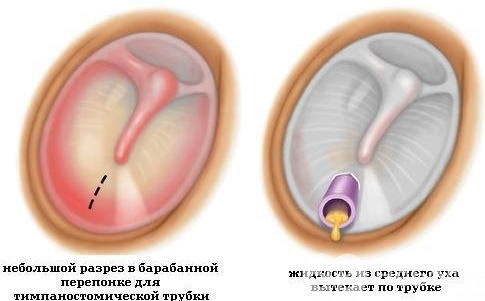
|
In most cases, at the end of the surgical intervention in the middle ear cavity after cleaning, the surgeon leaves a special tube to allow excess fluid to escape. Through it, additional washing with antiseptics or antibacterial agents is also carried out. Drainage is performed until all signs of the inflammatory process disappear completely.
Potential consequences and complications
Middle ear inflammation (treatment at home is carried out under the supervision of an otolaryngologist) must be treated without fail. Incorrect or untimely therapy will lead to serious consequences that are harder to cope with.
| Name | Description |
| Meningitis | The disease is characterized by inflammation of the meninges. Serious pathology that requires hospitalization of the patient. |
| Hearing loss | The pathological condition is accompanied by the accumulation of a large amount of pus in the cavity of the tympanic membrane. It becomes thinner, which significantly impairs hearing. |
| Facial nerve palsy | The conduction of nerve impulses is impaired. In the patient, the side of the face where the ear is affected is paralyzed. It is difficult for him to talk, eat or smile. |
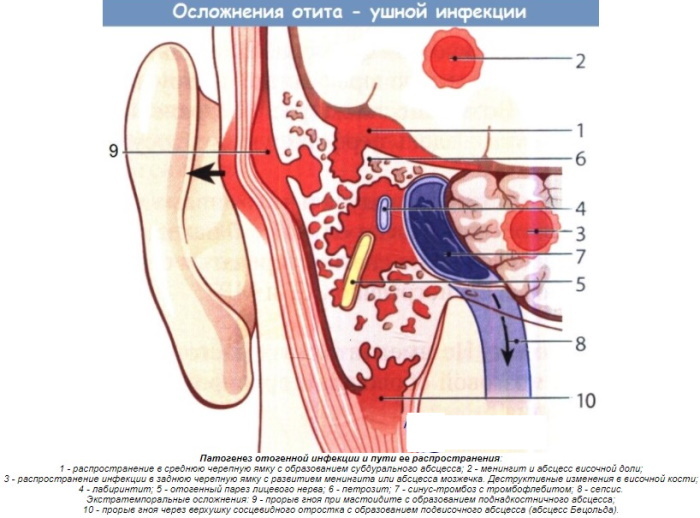
Mastoiditis is also a complication of the middle ear inflammation. The disease is characterized by damage to the mastoid process, which is located behind the auricle. The patient has partially or completely lost hearing, a severe headache appears. And the skin behind the ear turns red.
Middle ear inflammation is a serious condition. It can be treated at home, but strictly under the supervision of an otolaryngologist. Progressive inflammation can seriously impair human health. Therefore, even minor hearing problems require specialist advice.
Video about otitis media
Malysheva about otitis media:



